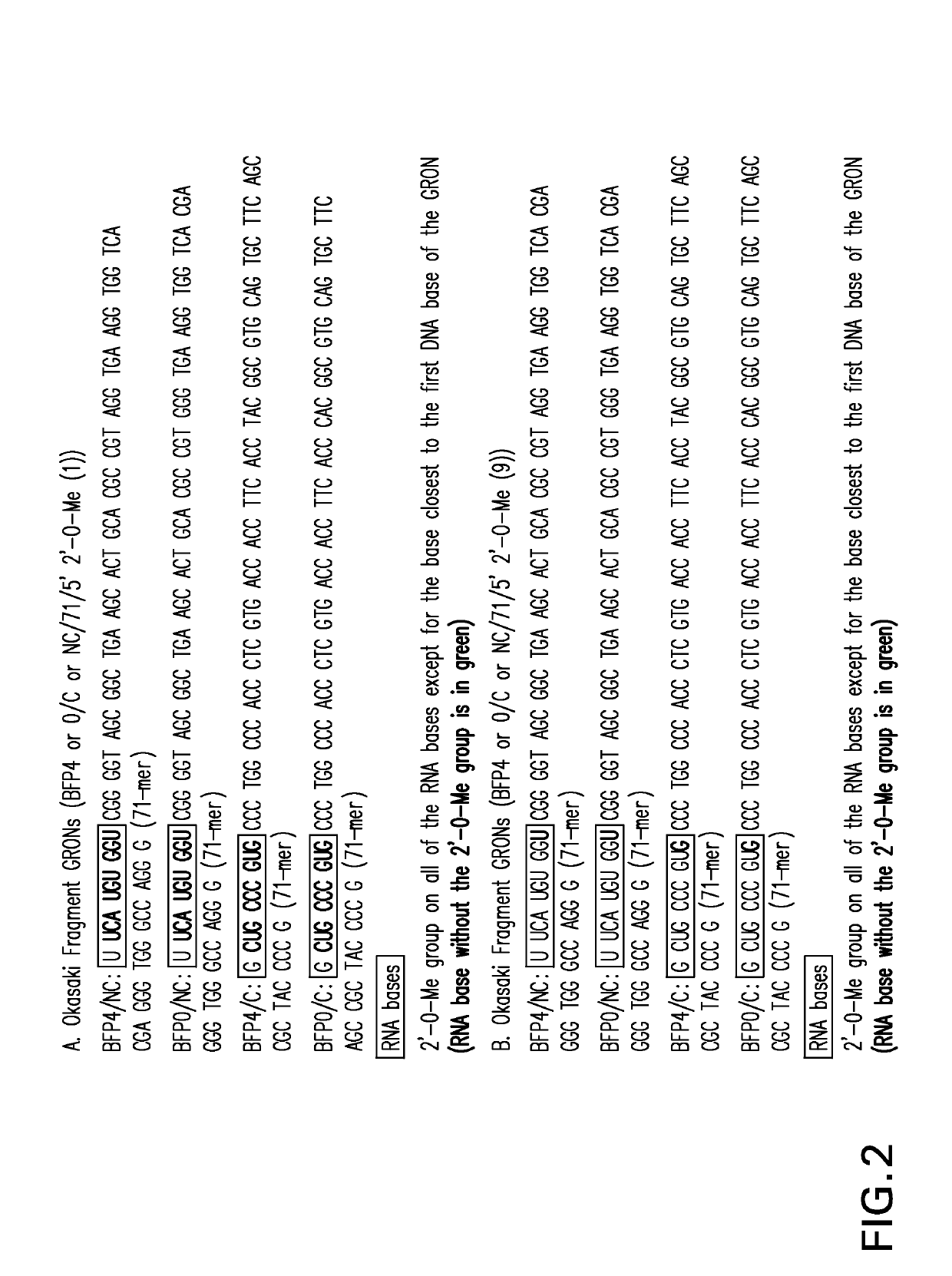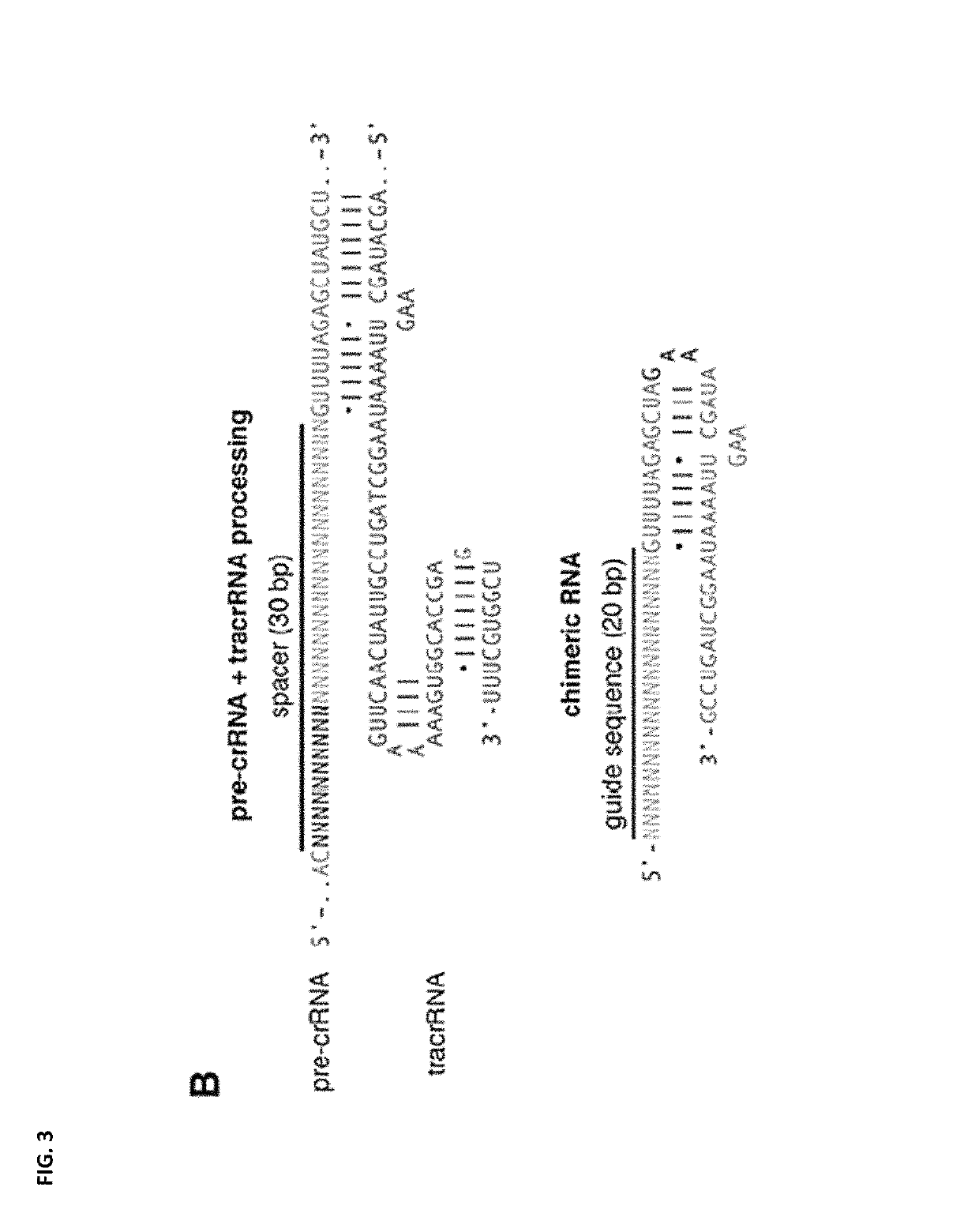Methods and compositions for increasing efficiency of targeted gene modification using oligonucleotide-mediated gene repair
a technology of oligonucleotide-mediated gene repair and composition, which is applied in the direction of hydrolases, biochemistry apparatus and processes, viruses/bacteriophages, etc., can solve the problems of low efficiency of homologous integration, limited frequency of modification and/or homologous recombination, and time-consuming process for gene modification, so as to enhance the availability of components of natural repair systems and improve the efficiency of targeting modification
- Summary
- Abstract
- Description
- Claims
- Application Information
AI Technical Summary
Benefits of technology
Problems solved by technology
Method used
Image
Examples
example 1
th
[0219]Sommer et al., (Mol Biotechnol. 33:115-22, 2006) describes a reporter system for the detection of in vivo gene conversion which relies upon a single nucleotide change to convert between blue and green fluorescence in green fluorescent protein (GFP) variants. This reporter system was adapted for use in the following experiments using Arabidopsis thaliana as a model species in order to assess efficiency of GRON conversion following modification of the GRON length.
[0220]In short, for this and the subsequent examples an Arabidopsis line with multiple copies of a blue fluorescent protein gene was created by methods known to those skilled in the art (see, e.g., Clough and Brent, 1998). Root-derived meristematic tissue cultures were established with this line, which was used for protoplast isolation and culture (see, e.g., Mathur et al., 1995). GRON delivery into protoplasts was achieved through polyethylene glycol (PEG) mediated GRON uptake into protoplasts. A method using a 96-we...
example 2
n Rates Using 5′Cy3 / 3′idC Labeled GRONs
[0232]The purpose of this series of experiments is to compare the efficiencies of phosphothioate (PS) labeled GRONs (having 3 PS moieties at each end of the GRON) to the 5′Cy3 / 3′idC labeled GRONs. The 5′Cy3 / 3′idC labeled GRONs have a 5′ Cy3 fluorophore (amidite) and a 3′ idC reverse base. Efficiency was assessed using conversion of blue fluorescent protein (BFP) to green fluorescence
[0233]In all three experiments, done either by PEG delivery of GRONs into protoplasts in individual Falcon tubes (labeled “Tubes”) or in 96-well plates (labeled “96-well dish”), there was no significant difference between the different GRON chemistries in BFP to GFP conversion efficiency as determined by cytometry (FIG. 1).
example 3
n Between the 41-Mer BFP4 / NC 5′-3PS / 3′-3PS GRON and Okazaki Fragment GRONs
[0234]The purpose of this series of experiments is to compare the conversion efficiencies of the phosphothioate (PS) labeled GRONs with 3PS moieties at each end of the GRON to “Okazaki fragment GRONs” in the presence and absence of a member of the bleomycin family, Zeocin™ (1 mg / ml) to induce DNA breaks. The design of these GRONs are depicted in FIG. 2. GRONs were delivered into Arabidopsis BFP protoplasts by PEG treatment and BFP to GFP conversion was determined at 24 h post treatment by cytometry. Samples treated with zeocin (1 mg / ml) were incubated with zeocin for 90 min on ice prior to PEG treatment.
[0235]In general the presence of zeocin (1 mg / ml) increased BFP to GFP conversion as determined by cytometry (Table 2). In both the presence and absence of zeocin, the NC Okazaki GRON containing one 2′-O Me group on the first RNA base at the 5′ end of the GRON was more efficacious at converting BFP to GFP when ...
PUM
 Login to View More
Login to View More Abstract
Description
Claims
Application Information
 Login to View More
Login to View More - R&D
- Intellectual Property
- Life Sciences
- Materials
- Tech Scout
- Unparalleled Data Quality
- Higher Quality Content
- 60% Fewer Hallucinations
Browse by: Latest US Patents, China's latest patents, Technical Efficacy Thesaurus, Application Domain, Technology Topic, Popular Technical Reports.
© 2025 PatSnap. All rights reserved.Legal|Privacy policy|Modern Slavery Act Transparency Statement|Sitemap|About US| Contact US: help@patsnap.com



